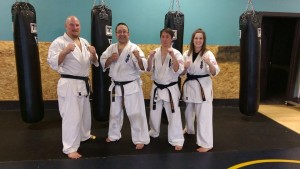
The cry “Hajime!” punctuates the rhythms of jogging and volleyball practice at the Smith Fieldhouse as BYU’s Kyokushin karate class begins for the evening.
Alfredo Chandia, 52, leads the yell of “Hajime!” at the top of his lungs. His students, dressed in white karate robes, or “Gis,” with belts of all colors, begin scissoring the air with punches, kicks and blocks.
For more than four years, Kyokushin Utah has been a free organization promoting the learning and practicing of Kyokushin karate, a rare form of stand-up, full-contact martial arts. Chandia founded the organization in 2010 with just himself and one other person.
Chandia believes that setting examples are the best ways of promoting the gospel, and martial arts, he said, is one of the best ways to set examples of hard work and dedication — attributes necessary for the gospel of Jesus Christ.
With hard work, determination and a warm personality, Chandia now teaches more than 30 students twice a week in the indoor track of the Smith Fieldhouse.
“I train Kyokushin karate. What makes us different is that we are bare-knuckle, full-contact martial art,” Chandia said. “Tournaments are bare-knuckle, full-contact.”
Bare-knuckle is the stunning difference that distinguishes Chandia’s students from ordinary martial arts organizations.
“We are not a feel-good place. You have to earn your belts. It’s an intensive training that provides a real feeling. It’s going to be useful for you in a real-life situation,” Chandia said. He has repeatedly expressed dissatisfaction in larger, revenue-driven organizations that, in his opinion, can promote their students too quickly to make them “feel good.”
Because Kyokushin Utah is free, Chandia focuses on what really matters, which is pushing his students to their limits and making sure they are well-educated in the world of Kyokushin karate.
Chandia was born in Santiago, Chile, and has been studying martial arts since 1977, having trained in Kyokushin karate since 1992. He currently works for BYU, managing the disposal of hazardous waste. He and his wife have seven children, many of whom study martial arts with him.
“Some of the greatest moments of my teaching have been watching my students earn their belts,” Chandia said. “Seeing my children enjoy the martial arts is something I enjoy.”

Kyokushin is a martial art founded in Japan by Korean Masutatsu Oyama in 1964. Kyokushin means “ultimate truth,” and the martial art is known for being extremely difficult and taxing on the body. This karate is full-contact with focus on self-improvement and discipline.
Its full-contact style has attracted worldwide attention, and an estimated 12 million have participated since its founding. Tournaments consist of full-contact kicks to the head but not hand strikes. The curriculum is taught through a series of seven different color belts.
Kyokushin Utah students are not expected to pay for their instruction, but they are responsible to pay for their own testing in graduation from one belt to another.
All are welcome to participate at all levels of experience. The group includes BYU students and members from the Provo and Orem communities.
For many students, Kyokushin Utah has provided confidence and a great addition to their way of life. It is certainly something that distinguishes them from other people. For Pamela Aguayo, 53, Kyokushin karate is a crucial part of her life.




